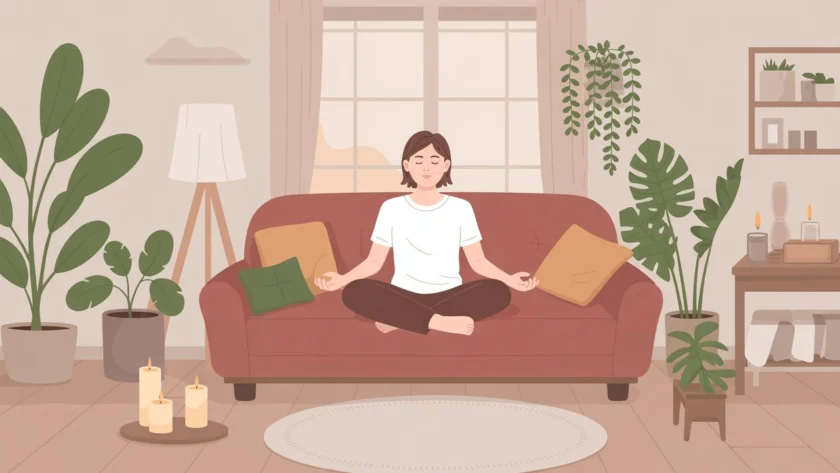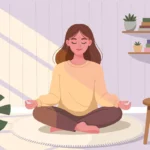I’ll never forget the day I stood in my living room, heart racing, and realized my own home had become part of my anxiety problem. Papers were stacked everywhere, dishes cluttered the sink, and honestly? Just walking through my front door made my shoulders tense. That was about seven years ago, right in the thick of my hardest anxiety season.
Here’s what I’ve come to understand: our physical spaces deeply affect our mental and spiritual well-being. You know how Jesus often withdrew to quiet places to pray? (Mark 1:35) There’s something profoundly important about having a sanctuary—a place where your nervous system can finally exhale. And for most of us, that place needs to start right at home.
Creating a calming environment for anxiety relief isn’t about having an Instagram-perfect house or spending thousands on a home makeover. It’s about intentionally shaping the space where you spend most of your time so it supports your healing instead of triggering your stress. Let me share what I’ve learned through my own journey and from working with hundreds of anxious hearts over the years.
Why Your Home Environment Matters for Anxiety
Before we dive into the practical stuff, let’s talk about why this even matters. When you’re dealing with anxiety, your nervous system is already on high alert—constantly scanning for threats, real or imagined. Visual clutter, harsh lighting, and chaotic spaces send signals to your brain that something’s wrong, that you need to stay vigilant.
I learned this the hard way. During my worst anxiety months, I’d come home from therapy exhausted, desperately needing rest. But my cluttered apartment kept my stress hormones elevated. My counselor—a wise woman who understood both faith and neuroscience—gently pointed out that I couldn’t truly rest in a space that felt chaotic.
Proverbs 14:30 tells us that “a tranquil heart gives life to the flesh.” Your home should be where your heart can find that tranquility. It should be a physical reminder that you’re safe, that God’s peace is available to you, that healing is possible.
Start with Decluttering: Clear Space, Clear Mind
Let me be honest with you—decluttering feels overwhelming when you’re already anxious. The idea of tackling years of accumulated stuff can trigger panic all by itself. So here’s what I want you to hear: you don’t have to do it all at once.
When I finally started addressing my clutter, I set a timer for just fifteen minutes. That’s it. I’d choose one small area—maybe the kitchen counter or my nightstand—and work on just that spot. Some days, Bailey (my rescue dog) would sit there watching me, and I’d talk to God while I sorted. “Lord, help me let go of what I don’t need. Show me what matters.”
Here’s my practical approach to decluttering for anxiety relief:
Start with the spaces you use most. Your bedroom, your morning coffee spot, wherever you typically sit to unwind in the evening. These are your priority zones because they have the biggest impact on your daily emotional state.
Ask yourself three questions about each item: Do I use this? Does this bring me peace or joy? Would keeping this honor the calm space I’m trying to create? If you answer no to all three, it’s probably time to let it go.
Create a “maybe box” for things you’re not sure about. One thing I’ve learned through therapy is that anxiety loves black-and-white thinking, and forcing yourself to make instant decisions about everything can be paralyzing. Give yourself permission to be uncertain.
The transformation that happens when you clear physical clutter is remarkable. I remember the first morning I woke up to a clean nightstand with just my Bible, a small plant, and a photo that made me smile. The difference in how I felt was immediate—like my bedroom was finally inviting rest instead of reminding me of unfinished tasks.
Embracing Calming Colors in Your Space
Now, I’m not suggesting you repaint your entire house tomorrow. But color psychology is real, and it matters for anxiety management. During my recovery, I slowly started shifting the colors in my home, and the impact surprised me.
Soft, muted tones genuinely help calm an overactive nervous system. Think about the colors you see in nature—gentle blues like the sky before sunset, soft greens from leaves and grass, warm neutrals like sand and stone. These aren’t just pretty; they’re biologically soothing.
In my bedroom, I gradually switched to sage green bedding and added some soft cream curtains. Nothing expensive or fancy—just intentional choices toward colors that didn’t stimulate my already-overstimulated brain. My living room has warm, earthy tones that remind me of Psalm 23’s “green pastures” and “still waters.”
Colors that support anxiety relief:
Blues and greens are your friends. They lower blood pressure and heart rate—exactly what an anxious body needs. You don’t have to repaint; even adding blue or green throw pillows or a cozy blanket can shift the energy of a room.
Warm neutrals create a sense of safety and groundedness. Beiges, soft grays, warm whites—these colors don’t demand anything from you. They just quietly support your nervous system.
Avoid too much red, bright orange, or intense yellow in your calming spaces. These colors are energizing, which is great for a home office or kitchen, but not ideal for areas where you’re trying to decompress. I learned this when I replaced my bright red accent wall with a soft taupe. My evening anxiety levels noticeably decreased.
Here’s something I tell people all the time: if you can’t change wall colors right now, change what you look at. Artwork with calming colors, a soft throw draped over your couch, even your phone wallpaper—these small visual shifts add up.
Bringing Nature Indoors: Plants and Natural Elements
This is where my inner gardener gets excited. Adding plants and natural elements to your home isn’t just about decoration—it’s about reconnecting with God’s creation in a way that grounds and heals you.
I started with one pothos plant in my living room. Just one. I named her Grace (yes, I name my plants), and caring for her became part of my morning routine. Watering Grace, checking her leaves, watching her grow—it gave me something living to nurture during a time when I felt pretty lifeless myself.
Research backs this up, but I didn’t need studies to tell me what I could feel: having plants in my space reduced my anxiety. They purify the air, yes, but more than that, they remind me that growth happens slowly, quietly, and that I’m part of something bigger than my anxious thoughts.
Easy plants for anxious beginners:
Snake plants are nearly impossible to kill and they clean the air beautifully. I have three in my bedroom, and they’ve survived my most distracted seasons.
Pothos and philodendrons are forgiving and grow quickly, giving you those little wins when you need encouragement. Watching new leaves unfurl feels like a tiny miracle every time.
Lavender isn’t just pretty—the scent genuinely calms your nervous system. I keep a small lavender plant near my favorite reading chair, and I’ll brush my fingers across it when I’m feeling tense.
But plants are just the beginning. Natural elements throughout your home create what I call “peace anchors”—physical reminders of God’s presence and creativity. I have a bowl of smooth river stones on my coffee table. When my hands need something to do during anxious moments, I hold one and pray. The weight and coolness of the stone grounds me.
Wood furniture and accents add warmth that plastic and metal just don’t provide. Natural fiber rugs, cotton curtains, a wooden cross on the wall—these elements connect us to the earth God made for us to inhabit.
I hung photos of nature scenes I find peaceful: a forest path, an ocean sunset, mountains. When anxiety tries to convince me the walls are closing in, I look at those images and remember there’s a whole beautiful world beyond my racing thoughts.
Creating Zones for Different Needs
Something that really helped me was creating distinct zones in my home for different purposes. When every space felt the same, my anxious brain couldn’t differentiate between “work stress” and “rest time.” Everything blurred together.
Your bedroom should be primarily for sleep and rest. I know that’s hard, especially if you live in a small space, but even small changes help. I removed my laptop from my bedroom and stopped scrolling through my phone in bed. I added a small table with my Bible, a journal, and a candle I light during evening prayer. This signals to my brain: this is a sacred space for rest and connection with God.
Create a specific prayer or meditation corner. Mine is just a comfortable chair near a window with good light, a small table holding my Bible and devotional books, and that lavender plant I mentioned. When I sit there, my body knows: we’re spending time with Jesus now. We’re letting go of control and resting in His presence.
If you work from home, try to separate your work zone from your relaxation spaces. I work at a desk in my spare room, and when I’m done for the day, I physically close the door. That simple action tells my nervous system: work is over. You can release that tension now.
Lighting That Soothes Instead of Stimulates
Here’s something I wish I’d understood earlier: harsh overhead lighting was making my anxiety worse. Fluorescent lights and bright white LEDs kept my nervous system activated even when I was trying to wind down.
I started using warm-toned bulbs throughout my home and added lamps instead of relying on overhead lights. The difference was immediate. Softer, warmer lighting signals to your brain that it’s okay to relax, to let your guard down.
Natural light during the day is crucial too. I open my curtains every morning as part of my routine, even when it’s cloudy. That connection to the natural rhythm of day and night helps regulate anxiety. God designed us to live with these rhythms—Ecclesiastes reminds us there’s “a time for everything, a season for every activity under the heavens.”
Candles have become part of my evening wind-down ritual. There’s something about firelight that’s been calming humans since the beginning of time. I light a candle, maybe put on some quiet worship music, and just breathe. Sometimes Bailey curls up at my feet, and we just exist peacefully together.
Sound and Scent: The Often-Forgotten Elements
Your environment isn’t just what you see—it’s what you hear and smell too. I learned to be intentional about these sensory experiences because they directly impact anxiety levels.
Noise was a huge trigger for me. My apartment building was loud, and I couldn’t control that, but I could control what sounds I added to my space. I started using a small fountain in my living room—the sound of flowing water became incredibly grounding. On difficult days, I’d sit near it and pray, letting the sound remind me of those still waters in Psalm 23.
Essential oils changed my anxiety management completely. I use a diffuser with lavender in the evening and peppermint in the morning. Scent goes directly to the emotional center of your brain, bypassing your rational mind. When I smell lavender now, my body automatically starts to relax because I’ve trained it through repetition.
Create a playlist of calming music or nature sounds for when you need to shift the energy in your home. I have instrumental worship music that I play during my morning coffee routine, and it sets a peaceful tone for my entire day.
Making It Work in Real Life
I know what you might be thinking: “This all sounds lovely, Amelia, but I have kids/roommates/a tiny apartment/no money for plants and new paint.” I get it. Real life is messy and complicated.
Here’s what I want you to hear: start small. Pick one thing from this article—just one—and do that. Maybe it’s clearing off your nightstand. Maybe it’s buying one plant. Maybe it’s changing one light bulb to a warmer tone.
When I was at my most anxious, I couldn’t handle big projects. But I could handle fifteen minutes. I could handle one small change. And those small changes accumulated into transformation.
God doesn’t ask us to do everything at once. He’s the God of “line upon line, precept upon precept” (Isaiah 28:10). He meets us in the small, faithful steps. The goal isn’t perfection—it’s progress toward a space that supports your healing.
Your Home as a Sanctuary
Creating a calming environment for anxiety relief is ultimately about honoring the truth that you need places of rest and peace. In our overstimulated, always-connected world, your home can become a sanctuary—a physical representation of God’s invitation to “be still and know that I am God” (Psalm 46:10).
I think about Jesus preparing the upper room for the Last Supper, creating an environment for meaningful connection. Or how God gave detailed instructions for creating the tabernacle—a beautiful space that reflected His peace and presence. Our homes might not be that elaborate, but the principle remains: the spaces we inhabit matter.
Your calming environment won’t eliminate anxiety completely. I still have hard days, moments when my heart races and my thoughts spiral. But coming home to a space that supports my healing rather than aggravating my stress makes those difficult moments more manageable.
As you work on creating your calming environment, be patient with yourself. Invite God into the process. Pray over your spaces. Ask Him to help you create a home that reflects His peace and reminds you of His constant presence.
Start today with one small thing. Clear one surface. Buy one plant. Change one light bulb. And then tomorrow, if you can, do one more small thing. Your future self—the one who walks into a calmer, more peaceful home—will thank you for starting this journey today.
Remember: you deserve a space that supports your healing. You deserve a home that whispers peace instead of shouting chaos. And with God’s help and these practical steps, you can create exactly that.



